How To Dehydrate Sourdough Starter + How To Rehydrate
Sourdough baking is a journey, a skill, and a joy. When you've dehydrated sourdough starter, you have the opportunity to save your starter for later, give it as a gift to those you love, or even sell it as a side hustle!
In this post you'll learn how to:
- Dry a sourdough starter with a dehydrator
- Preserve the starter in a dormant state for long-term storage
- How to rehydrate it
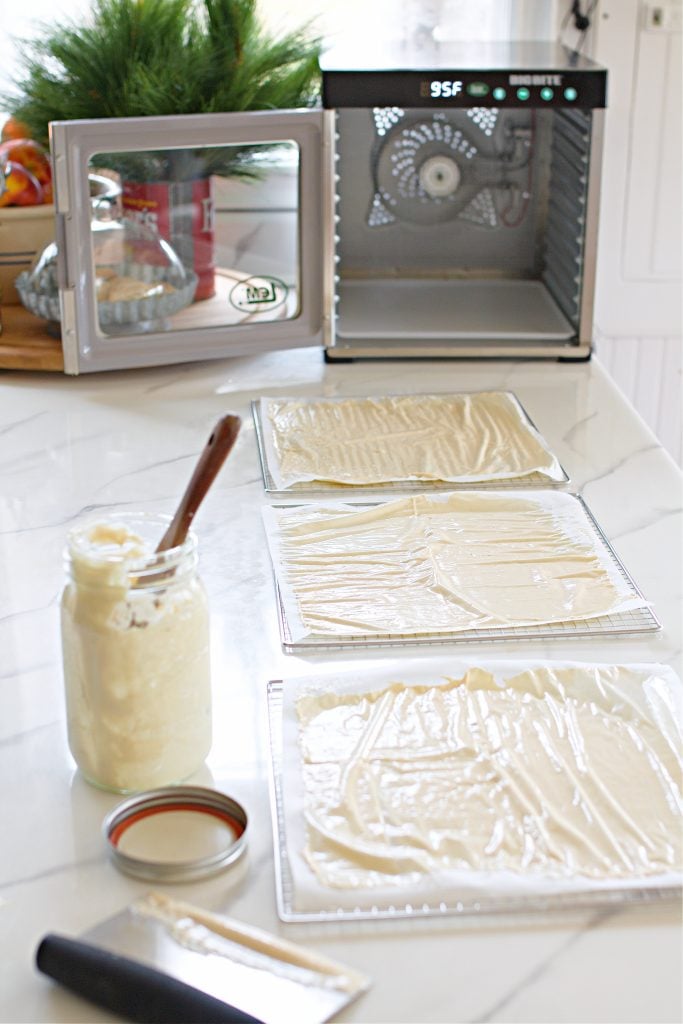
This tutorial on dehydrated sourdough starter is part of my Harvest Jar Gift Series
I've partnered with Roots and Harvest to share great gift ideas to give in their glass pint and quart jars over the holiday season. If you like this post make sure to check out the others we have in this series! And thank you to Roots and Harvest for making such high quality jars and canning supplies. Check them out and use code Eryn15 for 15% off your order + free shipping!
Harvest Jar Gift Series:
Why a Dehydrated Sourdough Starter is a Great Gift
A dry sourdough starter makes it easy to begin making all those sourdough goodies, whenever the recipient is ready to give it a try! Dried sourdough starter flakes are shelf-stable and easy to store in an airtight container. This makes them an excellent gift for friends, family, or anyone on their sourdough journey. The dry starter can be rehydrated to an active starter in just a few days.
Included at the end of this post is a printable recipe card to give with the starter so those who receive it know exactly how to bring it to life!
How Much Dried Sourdough To Package Per Recipient
When gifting or selling dried sourdough starter for someone to rehydrate, 5 to 10 grams of dried starter is typically sufficient. This small amount rehydrates well and contains enough active cultures to build a strong, healthy starter within a few feedings.
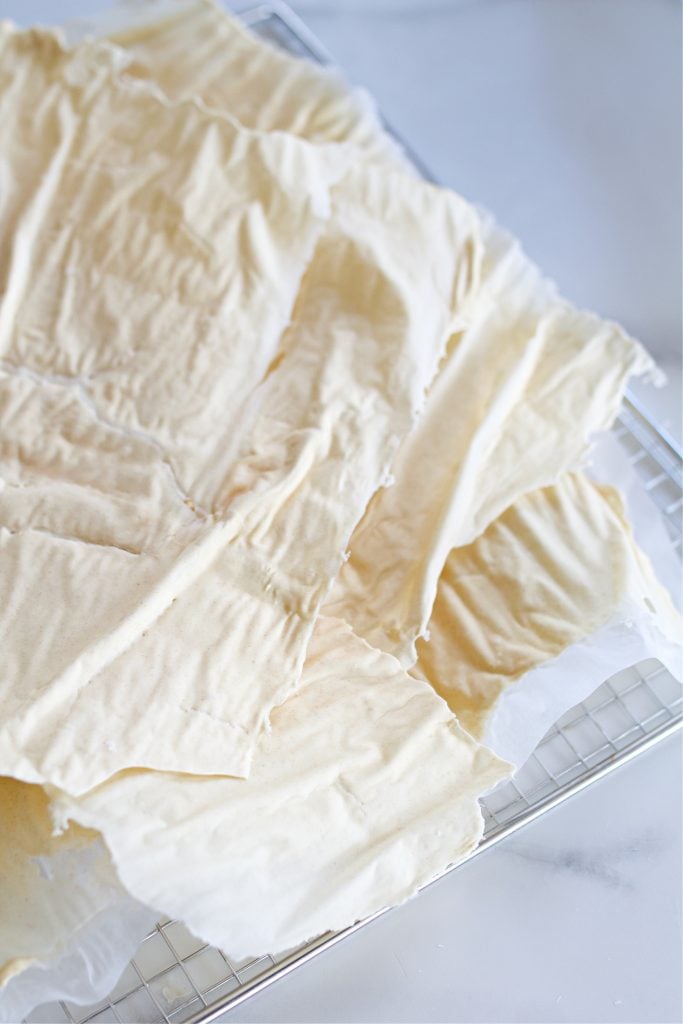
Here's why this range works:
- 5 grams is the minimum amount recommended to ensure enough active yeast and bacteria for a successful rehydration and growth process.
- 10 grams gives a bit of a buffer, especially if the starter is stored for a while before rehydration, as it provides extra cultures for a robust start.
A starter in this range is easy to store, economical to ship, and simple for the buyer to rehydrate, making it a practical option for those purchasing it to begin their sourdough journey.
Here's how to put together a charming gift jar with all the essentials for rehydrating and baking sourdough bread:
- Glass Jar: Use a quart-sized glass jar, adding 5 grams of the dried sourdough starter chips.
- Dried Starter: The key component to getting a robust starter going.
- Recipe Card: Include instructions for reactivating the dried starter and a sourdough bread recipe that's simple for beginners. (Find below)
- Spurtle: Attach a wooden spurtle for stirring and include the Rehydration Recipe Card below.
What Dehydrator I'm Loving For This Project
The BigBite Dehydrator from Roots and Harvest is a versatile tool for any homesteader or DIY enthusiast looking to preserve fresh foods, craft holiday decorations like dried oranges, and even dry a sourdough starter, like we're doing today.
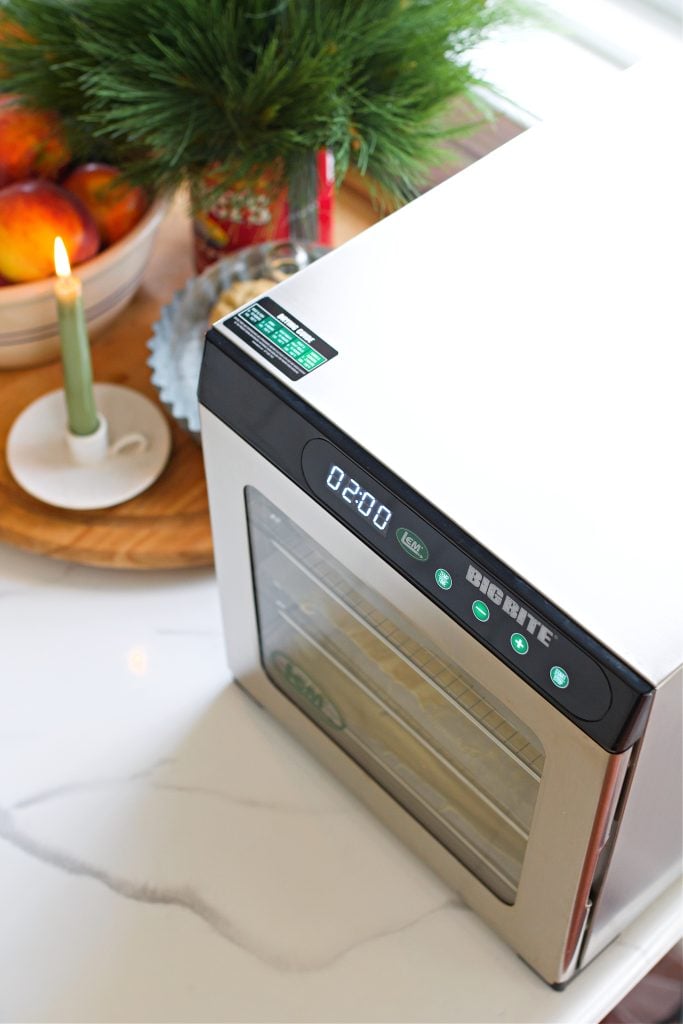
With its impressive 800-watt heating element, this dehydrator offers a temperature range from 95°F to 176°F, which is perfect for delicate items like sourdough starter and herbs as well as hearty foods like jerky and root vegetables. The 10 stainless steel trays provide 10 square feet of drying space, so you can dehydrate large batches at once.
For this project, I set it at 95F for three hours. I checked the starter every 30 minutes to make sure it was progressing well. The time range for you is going to vary a bit depending on the dehydrator you're using. Keep an eye on it and check every half an hour or so.
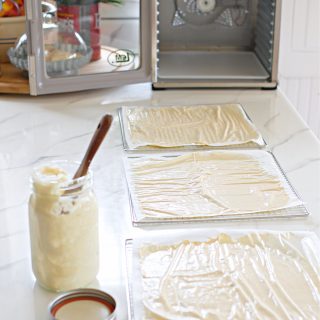
How to Dry a Sourdough Starter with A Dehydrator
Equipment
- 1 sheet parchment paper and a spatula
- 1 Dehydrator
- 1 Airtight container like a Mason jar, for storing the dried starter
- 1 Stir stick for gift giving
- 1 How to Rehydrate Recipe Card (Included at end of this post)
Ingredients
- 1 cup Active sourdough starter at peak activity
Instructions
- Prepare the Starter: Start with a healthy sourdough starter that has been fed and reached peak activity. A mature sourdough starter is ideal for drying.
- Spread on Tray: Spread a very thin layer of starter across a parchment paper. The thinner, the better, to reduce drying time and ensure that the starter dries evenly.
- Set the Dehydrator: Set the to around 95°F and let the drying process continue for 24-48 hours until the starter is brittle and completely dried. This low-temperature drying is the best way to preserve the good bacteria and yeast spores in your starter. In general, a sourdough starter begins to get too hot and may start dying off at temperatures around 113°F (45°C) or higher. At these temperatures, the wild yeasts and beneficial bacteria are at risk, so keeping the drying process below 100°F is ideal for preserving the starter's viability.
- Break into Small Pieces: Once dried, break the starter into small pieces or dried sourdough starter chips. Using a food processor is an easy way to turn the dried form into powder if preferred, which can be helpful for long-term storage in a Mason jar or airtight container.
- Store in an Airtight Container: Transfer the dried starter chips to a clean jar. Use a rubber band and plastic wrap or an airtight lid to seal the jar and keep the starter dry.
- Store in a cool dry place away from sunlight for a very long time.
Notes
Spreading your starter in a very thin layer helps it dry faster and more evenly. Aim for about ⅛ inch thick. Checking for Full Dehydration
Your starter should feel dry, brittle, and snap easily when broken. Any remaining moisture can reduce shelf life, so make sure it’s fully dry before storing. Storage Tips
Store the dried starter in an airtight container, like a Mason jar with a rubber-sealed lid, to keep it from absorbing moisture.
Keep in a cool, dry place away from light, like a pantry or cupboard, to maintain its quality for up to a year. Using the Dehydrated Starter
When you’re ready to bake, rehydrate your dried starter by following the reactivation instructions. It’s like bringing your starter back to life, and it will be just as bubbly and active as before with a few feedings. Great for Sharing
Dried starter makes a wonderful gift! Package it in small jars or bags with rehydration instructions for friends or family who want to begin their sourdough journey. Troubleshooting
If you notice any off smells, discoloration, or mold during storage, it may mean that moisture has gotten in. Discard the starter and try dehydrating a fresh batch to avoid any issues with mold or contamination.
Nutrition
When your dehydrated sourdough starter is given as a gift or sold, make sure to include a great rehydration plan with your starter. Below is the one I love to give out! Print and use it if you'd like!
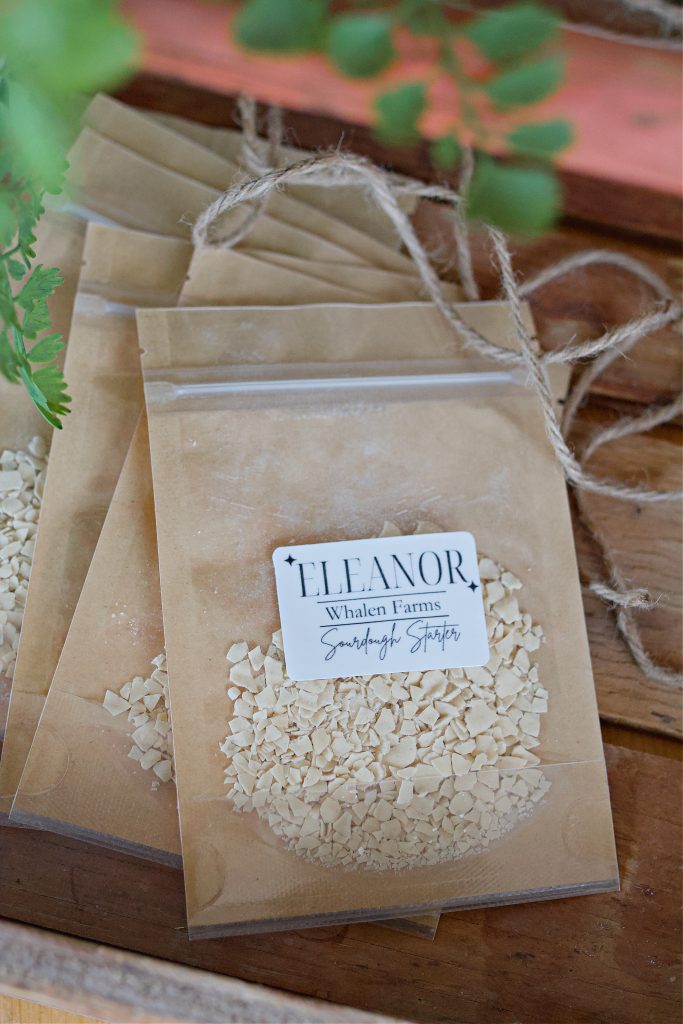
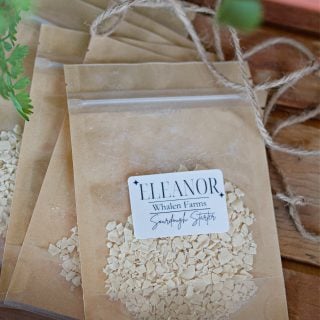
How to Reactivate Dried Sourdough Starter
Ingredients
- 10 grams Dried sourdough chips
- 20 grams Filtered lukewarm water
- 10 grams Flour
Instructions
- Rehydrate the StarterIn a clean jar, combine 10 grams dried starter with 20 grams lukewarm water. Stir gently until the starter dissolves in the water.Let this mixture sit uncovered at room temperature for 2-4 hours.
- First FeedingAfter 2-4 hours, add 10 grams flour and 10 grams water to the rehydrated starter. Mix until smooth.Cover loosely with plastic wrap or a cloth, and let it sit at room temperature for 12-24 hours.
- Daily Feeding with Discard (Days 2-4)Each day, discard about half of the starter mixture (roughly 20 grams) before feeding.Feed the remaining starter with 20 grams flour and 20 grams water. Stir thoroughly, cover loosely, and let it sit at room temperature.Discarding daily keeps the starter from growing too large and helps concentrate the wild yeasts and bacteria.
- Look for Signs of ActivityOnce the starter is bubbly, has a pleasant aroma, and doubles in size within 4-6 hours after feeding, it's fully active and ready to use!If it needs more time, continue daily feedings (with discards) until it shows these signs of activity.
- Tips for Success:Keep Warm: For best results, keep the starter in a warm spot (70-75°F).Be Patient: It may take a few days for the starter to fully activate. Just keep feeding and discarding daily until it's bubbly and active.Regular Feeding: Once active, feed it daily if kept at room temperature, or store it in the fridge and feed weekly if baking less frequently.Your starter is now ready to use in all your sourdough recipes-happy baking!
Notes
Once your starter is active and established (bubbly and doubling after feedings), you can stop discarding daily unless you're reducing the quantity. From then on, you'll only need to discard if you're storing it for longer periods or maintaining a manageable amount. Switching to Regular Feedings
Once activated, keep your starter at room temperature and feed it daily, or store it in the fridge if baking less frequently. Feed your refrigerated starter weekly to keep it healthy and ready to use. What to Do with Discarded Starter (and Why Not to Use It Yet)
Why Discard Starter During Activation?
During the first few days of rehydrating and feeding your dried starter, you’ll need to discard a portion of it daily. This might feel wasteful, but it’s an important step! Early in the process, the starter is still developing the balance of wild yeasts and lactic acid bacteria that make it bubbly, tangy, and effective for baking. At this stage, the starter is not yet strong or stable enough to add flavor, leavening, or fermentation benefits to recipes. Think of these early days as “training” for your starter—it needs time to build up strength! When Can You Start Using Discard?
Once your starter is fully active (bubbly, doubling in size, and smelling pleasantly sour) after regular feedings, you can begin using the discarded portions in recipes. Typically, this is after about 5-7 days, depending on temperature and environment.
Nutrition
Tips for Long-Term Storage of Dried Sourdough Starter
- Store the dried starter in a cool, dark place for the longest shelf life.
- For added freshness, keep the starter in a ziplock bag within the jar, ensuring no air exposure.
- Dried starter can be an "insurance policy" if you need to preserve some of your sourdough discard or keep a backup starter on hand.
This holiday season, give the gift of sourdough baking with a homemade starter jar.
This simple process preserves the healthy lactic acid bacteria and yeast of your active starter, ensuring it will last for a very long time in dried form. A sourdough starter from your kitchen is a gift that brings warmth, good food, and a taste of your home to their table.

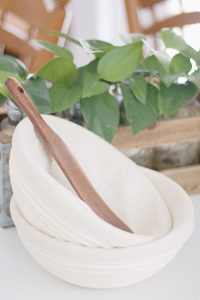


I’ve been drying my sourdough starter for years now, and it’s truly one of the best ways to preserve and share a little piece of my kitchen with others. I always keep a jar tucked away as backup “insurance” for my main starter, and I love gifting it during the holidays. Watching someone rehydrate it and bake their first loaf makes it all the more special, it’s like passing on a bit of homestead tradition.